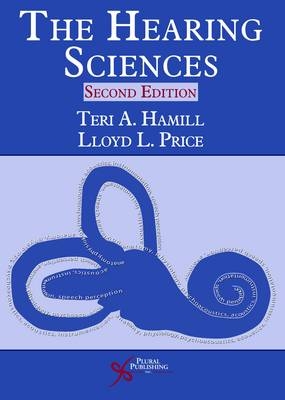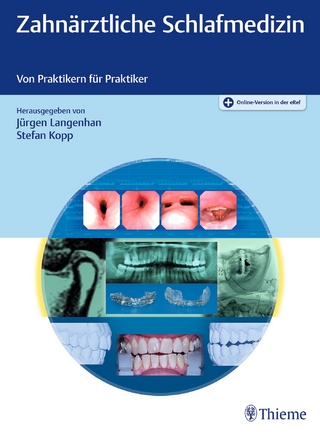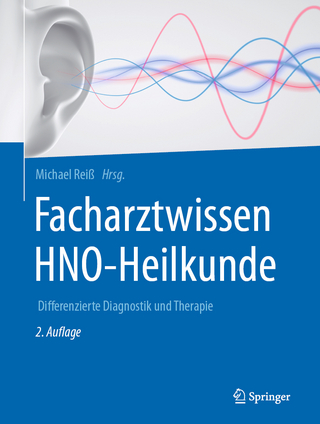
The Hearing Sciences
Plural Publishing Inc (Verlag)
978-1-59756-540-0 (ISBN)
- Titel z.Zt. nicht lieferbar
- Versandkostenfrei innerhalb Deutschlands
- Auch auf Rechnung
- Verfügbarkeit in der Filiale vor Ort prüfen
- Artikel merken
The Hearing Sciences, Second Edition addresses all the topics critical to understanding the hearing sciences: acoustics, anatomy and physiology of the auditory and vestibular systems, psychoacoustics, and basic instrumentation. Written in a straightforward approach, each chapter opens with an introduction of the key concepts and ends with a concise summary. The practical nature of the book is demonstrated in the "Clinical Correlates" examples, which relate elements of the hearing sciences to patient care and engage students in the concepts. The textbook is designed for undergraduate students - the more advanced chapters are useful supplementary material in graduate audiology programs - but through this book, students will gain invaluable insight into the hearing sciences before ever taking a course in audiology. New to this edition: New and improved illustrations Updated information on cochlear physiology An added bonus is in the companion website: www.audstudent.com/resources, which contains support and extension activities to help students apply concepts to practice.
Teri A. Hamill, Ph.D., is Professor of Audiology at Nova Southeastern University, where she teaches Au.D. students. Lloyd L. Price, Ph.D., Professor Emeritus of Audiology, taught undergraduate and graduate courses in the hearing sciences at Florida State University. When he began teaching an undergraduate hearing science course in 1983, there were no texts suitable at that level. In order to cover the material he wished to cover, it was necessary to develop a text, which evolved over a fifteen-year period. Price has background in both clinical audiology and academia. He worked as a professor for thirty-one years after having worked clinically for the previous nine years. Price is now retired, living in Havana, Florida with his wife, Cindy.
Preface Acknowledgments and Dedication About the Authors Section one: Basic Acoustics and Instrumentation Chapter 1. Physical Properties of Sound Energy Opposing Forces Units of Measurement Sound Energy Comical Correlate: Einstein, Newton, and Pascal Compression and Rarefaction Frequency Intensity Limits of Human Frequency Detection Summary Chapter 2. Ratios, Logarithms, and Decibels Ratios Exponents Positive Exponents Negative Exponents Zero Exponent Laws of Exponents Addition Subtraction Multiplication, Division, and Exponents of Exponents Scientific Notation Adding and Subtracting Numbers in Scientific Notation Logarithms Are Based on Exponents Logarithms of Numbers with Only 1 and 0 Logarithms of Numbers Other Than 1 and 0 Why Are Logs Important? Antilogs The Log of X Times Y Log of (X Divided by Y) Hints on Using the Calculator Obtaining the Log of a Number That Is Raised to a Power The Decibel Power Pressure Practice at Calculating Sound Pressure Levels Practice at Calculating Intensity Levels Relative Powers and Pressures Adding Decibels Summary Chapter 3. Further Examination of Properties of Sound Speed of Sound Transmission Wavelength Period Relationship of Period and Wavelength Sound Transmission Effects Diffraction and Reflection Sound Absorption, Transmission Loss, and Reverberation Time The Doppler Effect Sonic Booms and Thunder Temperature Changes Affect Speed of Sound Types of Decibel Scales Review of dB SPL and dB IL dB Increase dB HL and SL Introduction to the Audiogram Summary Chapter 4. The Sine in Sine Waves and Other Types of Sound Waves Triangles and Sines Plotting Sine Waves Simple Harmonic Motion, the Pendulum, and the Circle Molecular Vibration and the Sine Wave How We Calculate Relative Amplitude When Phase is Known How We Calculate Phase When Time and Frequency Are Known Complex Sound Summing Pure Tones That Differ Only in Phase or Amplitude Summing Pure Tones That Differ in Frequency Harmonics and Distortion Air Molecule Vibration Pattern for Complex Sounds Fourier's Theoum Common Types of Tones and Noise The Click (Transient) Signal Waveform Rise and Fall Envelopes Clinical Correlate: Tone Burst Durations for Testing Infants Summary Answers to Chapter Problems Chapter 5. Impedance, Energy Transfer, and Resonance Impedance Impedance of a Medium Energy Transfer Resonance of Systems Standing Waves and Resonances of Tubes Standing Waves Resonances of a Tube Closed at One End Resonances of a Tube Closed at Both Ends Summary Chapter 6. Electricity and Analog Systems Electron Flow Ohm's Law Electrical Circuits Ion Flow Common Analog Components Microphones Amplifiers Filters Speakers Transducers Volume Controls Frequency Response Controls Summary Chapter 7. Digital Systems and Digital Signal Processing Bits and Sampling Rates How Big Is That? How Often Should Amplitude Be Measured? Building an Analogy to Use Later Additional Digitization Concepts Analog to Digital Converters Nyquist Frequency Digital to Analog Converters Imaging Anti-imaging filters Overview of What a Digital System Can Do Fast Fourier Transform Analysis of Auditory Signals Windowing Goal of FFT analysis Clinical Correlate: Bins in Audiology Time Domain Signal Averaging Hearing Aid Digital Noise Reduction Clinical Correlate: Digital Hearing Aids Summary Chapter 8. Some Equipment Used in Audiology and Hearing Science Audiometers Signal Generators Sound Booths Immittance Devices (Middle Ear Analyzers) Tympanometers Acoustic Stapedial Reflex Measurement Otoacoustic Emissions Devices Spontaneous Otoacoustic Emission Measurement Transient-Evoked Otoacoustic Emissions Measurement Distortion-Product Otoacoustic Emissions Measurement Signal Processing Used in Analysis of All Types of OAE Measurements Auditory Evoked Response Measurement Systems Common Mode Rejection Time-Domain Signal Averaging and Artifact Rejection Filtering the Evoked Response Hearing Aid Analyzers Real-Ear Measurement Systems Speech Mapping Technology Traditional Real-Ear Testing Power Supplied for Hearing Instruments and Testing Equipment: Safety Concerns and Electronic Noise Relative Safety of AC and DC Power Supplies What Is AC Electricity? Ground Noise Grounding Equipment, Fuses, and Circuit Protectors Floor Noise Microphones Types of Microphones Microphone Directionality Microphone Care Sound Level Meters Calibration of Sound Level Meters Types of Decibel Scales Sound Level Meter Response Times Decibel Range Selection Earphone Couplers Calibration of Audiometer Output Level: Reference Equivalent Threshold Levels Frequency Counters Audiometer Calibrators Oscilloscopes Summary Section Two: Introduction To Speech Acoustics Chapter 9. Classification of Speech Sounds Consonants, Vowels, and Diphthongs Consonants Are Categorized by Place of Articulation, Manner of Articulation, and Voicing Alveolar Sounds Palatal Sounds Glottal Sound Velar Sounds Linguadental Sounds Bilabial Sounds Labiodental Sounds Clinical Correlate: The Limits of Lip Reading Vowels Differ in Tongue Height, Placement, Tension and Lip Rounding Front Vowels Central Vowels Back Vowels Summary Chapter 10. Acoustics of Speech How Speech Sound Waveforms Can Be Viewed Fundamental Frequency, Harmonics, and Formant Frequencies Acoustic Characteristics of Vowels Formant Frequencies Are Created by Resonance of the Vocal Tract F1 and F2 of Vowels Intensity of Vowel Sounds Low Importance of Vowels for Speech Understanding Acoustic Characteristics of Consonants Stop Consonant Burst Energy Is Wideband Voice Onset Time Distinguishes Voiced and Unvoiced Sounds Formant Frequency Transitions Provide Additional Acoustic Cues Fricatives Have Longer Duration and High-Frequency Energy Affricatives Have Characteristics of Both Plosives and Fricatives Nasals Have Low-Frequency Energy, Nasal Murmur, and Antiresonances Clinical Correlate: Some Noise-Reduction Strategies Can Make Speech Sound Nasal Glides Are Characterized by Vowel Formant Transitions Intensity of Consonants Importance of Consonants for Speech Understanding Clinical Correlate: Shouting Doesn't Help Most Hearing-Impaired People Summary Section Three: Anatomy and Physiology of the Ear Chapter 11. Overview of Anatomy and Physiology of the Ear Anatomic Terms for Location Anatomic Views General Sections of the Ear Clinical Correlate: Types of Loss The Temporal Bone Overview of Physiology Summary Chapter 12. Introduction to the Conductive Mechanisms The External Ear The Middle Ear The Tympanic Membrane Overview of the Middle Ear Structures and Landmarks The Ossicles Overview of How Middle Ear Ossicular Motion Permits Hearing Medial Wall Landmarks Posterior Wall Landmarks The Lateral or Tympanic Wall Anterior Wall Middle Ear Muscles The Eustachian Tube Summary Chapter 13. Introduction to the Physiology of the Middle Ear Resonances of the External Ear Energy Transfer Through the Middle Ear Impedance Mismatch Between Air and Cochlear Fluids The Middle Ear as an Impedance-Matching Transformer The Acoustic Reflex Summary References Chapter 14. Bone-Conduction Hearing Bone-Conduction Mechanisms Skull Vibration Intertial Aspects of Bone Conduction Compressional Aspects of Bone Conduction Osseotympanic Aspects of Bone Conduction: Bone Conduction by Air Conduction Hearing Is Tested by Air and Bone Conduction Clinical Correlate: Diagnosing Conductive Bone Conduction by Air Conduction and the Occlusion Effect Summary Clinical Correlate: Third-Window Disorders References Chapter 15.Advanced Conductive Anatomy and Physiology Pinna Embryologic Development Landmarks Physiology of the Pinna Clinical Correlate: Defects of the Outer Ear May Signal Middle and Inner Ear Defects External Auditory Meatus Detailed Anatomy Clinical Correlate: Otoscopy and Earmold Impressions Proximity to the Temporomandibular Joint Proximity of Nerves to the External Auditory Meatus Clinical Correlates: TMJ Pain and the Effect of TMJ Movement on Earmold Impressions Skin of the External Auditory Meatus Cerumen Clinical Correlate: Cerumen Management Detailed Physiology of the External Auditory Meatus Clinical Correlate: Real-Ear Measurement Tympanic Membrane Slant and Cone Depth Clinical Correlate: Cone of Light Detailed Study of the Ossicular Chain Resonance of the Middle Ear Mass and Stiffness of the Middle Ear Affect Sound Transmission Differently at Different Frequencies Clinical Correlate: Carhart's Notch Transmission of Sound Through the Tympanic Membrane Is Affected by Mass and Stiffness Clinical Correlate: Carhart Notch Clinical Correlate: Measuring Middle Ear Resonance Clinical Correlate: Measuring Middle Ear Pressure Acoustic Reflex Physiology Reflex Latency Clinical Correlate: Measuring Acoustic Reflex Latency Reflex Adaptation Reflex Threshold Clinical Correlate: Measuring Acoustic Reflex Decay Clinical Correlate: Reflex Threshold Testing May Reveal Type of Hearing Loss Summary Reference Chapter 16. Introduction to the Sensory Mechanics The Bony Labyrinth The Membranous Labyrinth The Vestibular System The Cochlea Structures Within the Cochlea Gross Structures Fine Details of Features in the Cochlea Mass and Stiffness Differences Along Basilar Membrane Review of How the Detailed Features Fit Within the Larger Picture Cochlear Blood Supply Innervation of the Cochlea Summary Chapter 17. Advanced Study of the Anatomy of the Cochlea Hair Cell Height and Number Stereocilia and Their Tip Links and Side Links Supporting Cells Chemical Composition of Endolymph and Perilymph Comparative Electrical Charges of Fluids in the Cochlea Potassium Influx Regulates Calcium Coming into Hair Cells Circulation of Ions Clinical Correlate: Gap Junctions and Deafness Neurotransmitter Release Summary Chapter 18. Introduction to Cochlear Physiology Arrangement of the Cilia Relative to Tectorial Membrane Mass/Stiffness Gradient of the Basilar Membrane Review of Divisions and Membranes Within the Cochlea The In-and-Out Motion of Stapes Footplate Becomes an Up-and-Down Motion of Basilar Membrane, Called the Traveling Wave The Location of the Maximum Place of Movement on the Basilar Membrane Is Determined by the Sound Frequency An Unfortunate Untwisting Fate The Height of the Traveling Wave Envelope Is Related to Sound Intensity Ciliary Shearing Returning to the Concept that the Up-and-Down Basilar Membrane Motion Creates Side-to-Side Shearing of the Hair Cell Cilia Shearing of Cilia Opens Microchannels (Mechanoelectrical Transduction Channels) in the Cilia and Creates Chemical Changes in the Hair Cell Body The Outer Hair Cell Active Mechanism Enhances the Motion of the Inner Hair Cell Cilia Hearing Requires Inner Hair Cell Stimulation Summary Chapter 19. More Hair Cell Physiology Calcium and Potassium Channels, Prestin, and Actice Cilia Review of Cellular Chemistry Changes Prestin Protein Contraction Creates the Active Mechanism Hair Cell Cilia Also Appear to Have Actice Properties Tip Links and Insertion Plaques: Slow Cilia Adaptation Clinical Correlate: Temporary Threshold Shift Apoptosis- A Better Way for Hair Cells to Die Reactive Oxygen Species Antioxidants Summary Chapter 20. Overview of Cochlear Potentials and the Auditory Nervous System Chemical Changes in the Hair Cells and Neurons The Cochlear Microphonic The Summating Potential Action Potentials Clinical Correlate: VIIIth Nerve Tumors Cause High-Frequency Hearing Loss Pattern of Neural Firing Encodes Frequency and Intensity The Primary Afferent Auditory Pathway Location of Afferent Neuron Dendrites Course of the VIIIth Nerve Cerebellopontine Angle Nuclei Primary Auditory Cortex Introduction to Efferent Neurons Clinical Correlate: Auditory Brainstem Response Testing Measures Synchronous Neural Discharge Clinical Correlate: Right-Ear Advantage Summary Reference Chapter 21. Advanced Study of Cochlear and VIIIth Nerve Potentials Characteristic Frequency Cochlear Resting Potentials Endocochlear Potential Intracellular Potentials Cochlear Receptor Potentials Cochlear Microphonic Summating Potential Comparison of the Tuning of the Cochlear Microphonic and the Summating Potential Clinical Correlate: Meniere's Disease and Enhanced Summating Potentials Summary of Cochlear Microphonic and Summating Potential Action Potentials Electrical Potentials in Neurons Refractory Period Spontaneous Discharge Rates Threshold of Neural Firing Is Related to Spontaneous Discharge Rate Firing Rates Influenced by Efferent Innervation Pure-Tone Frequencies and Intensities That Cause a Neuron to Fire Faster Than Spontaneous Rate Upward Spread of Masking - Masking of One Stimulus by a Second Neural Tuning Curves How Neural Tuning Curves are Obtained Q10 dB Calculations Describe Width of Tuning Curve Tips Summary Reference Chapter 22. How Frequency and Intensity Information Are Encoded by VIIIth Nerve Fibers Rate of Firing of One Neuron Increases as the Stimulus Frequency Approaches Characteristic Frequency Different Combinations of Frequency and Intensity Can Create the Same Overall Number of Neural Discharges Per Second Problems with the Theory That Frequency Is Encoded by Rate of Discharge Pattern of Neural Discharge Encodes Frequency and Intensity Whole Nerve Potentials Versus Single Nerve Potentials to Single Pure Tones Limits on a Neuron's Firing "In Phase" with Signals Angry Bird Analogy A Neuron Will Phase-Lock to Which Pure Tone Frequencies? A Single Pure Tone Phase-Locks Which Neurons? Clinical Correlate: What the Auditory Brainstem Response Measures and How the Auditory Steady-State Response Differs Masking of One Sound by a Second Sound Poststimulus Time Histograms Obtained When Stimulating the Ear with Clicks and the Concept of Preferred Intervals Response of Multiple Neurons of the Same Characteristic Frequency Period Histograms: Histograms Obtained with Pure-Tone Stimulation Review of the Response of the VIIIth Nerve to Pure Tones Response of the VIIIth Nerve to Complex Signals Additional Information Is Obtained from Early and Late Neural Firings Summary Chapter 23. The Efferent Auditory System Olivocochlear Bundle Medial Efferent System Lateral Efferent System Crossed and Uncrossed Efferent Fibers Effect of Activation of the Efferent System Memory Aids Other Efferent Pathways The Acoustic Reflex Stapedial Reflex Pathway Effect of Stapedial Reflex Contraction Role of Tensor Tympani Acoustic Reflexes Elicited by Nonauditory Stimuli Summary Chapter 24. Peripheral Vestibular Anatomy and Physiology The Vestibular System Bony and Membranous Labyrinths Arrangement of the Semicircular Canals Planes of the Canals of the Right and Left Ears are Aligned Clinical Correlate: Orienting the Horizontal Semicircular Canal Anatomy and Physiology of the Semicircular Canals Structures Within the Ampullae of the Semicircular Canals Angular Head Motion Directions Cilia and Kinocilium in the Ampullae Direction of Endolymph/Cupula Movement That Is Excitatory The Utricle and Saccule Hair Cells of the Utricle and Saccule Vestibular Branch of the VIIIth Nerve Clinical Correlate: Vestibular Assessment of Each Branch of the Vestibular Portion of the VIIIth Nerve Clinical Correlate: Benign Paroxysmal Positional Vertigo Summary Further Reading Chapter 25. Central Vestibular Anatomy and Physiology Functions of the Balance System Awareness of Head Position The Vestibular-Ocular Reflex Clinical Correlate: Unilateral Peripheral Lesions Cause Nystagmus That Beats Toward the Unaffected Ear Reflexes of the Balance System for Postural Control Clinical Correlate: Overview of Balance Assessment- Posturography Summary of the Functions of Balance and Clinical Implications Clinical Correlate: Overview of the Video- and Electrostagmography Summary Section 4: Basic Psychoacoustics Chapter 26. Introduction to Psychoacoustics The Threshold (in DB SPL) for Pure Tones Depends on Frequency Two Ears Are Better Than One Under Ideal Circumstances, A Person Can Detect a 1-dB Intensity Change In General, a 10-dB Increase in Intensity Is About a Doubling of Loudness (Some STudies Say 6 dB) Loudness Grows a Bit Differently in the Low Frequencies: An Introduction to Phon Curves Pitch When Is a Pure Tone Tonal? Detecting Change in Pitch Doubling Frequency Creates a Musical Sameness but Not a Doubling of Pitch Masking Upward Spread of Masking Critical Bands Temporal Processing Sounds Are Louder and of Better Pitch if at Least One-Quarter Millisecond Duration Temporal Order Detection Gap Detection Summary and Implications for Speech Perception Chapter 27. Classical Psychoacoustic Methodologies Classic Psychoacoustic Methods Method of Limits Method of Adjustment Clinical Correlate: How Instruction Affects Patients' Responses Clinical Correlate: Nonorganic Loss Detection Using Lack of False Positive Responses and Latency Inconsistencies Clinical Correlate: Ascending Testing in Nonorganic Loss Method of Constant Stimuli Newer Methods Adaptive Up-Down Methods Introduction to Forced-Choice Methods Introduction to Signal Detection Theory Scaling Procedures Magnitude Estimation Clinical Correlate: Scaling Procedures Are Used Clinically Magnitude Production Fractionation Cross-Modality Matching Summary Reference Chapter 28. Signal Detection Theory and Advanced Adaptive Approaches Signal Detection Theory Understanding "Magnitude of the Sensory Event" Signal Plus Noise Perception Criterion Points for Decision-Making and How Hit and Correct-Rejection Percentages Reveal Spacing Between the Noise and Signal-plus-Noise Distributions Altering Subject Criteria in Signal Detection Theory and Receiver Operating Curves The Magic of d' Clinical Correlate: Clinical Tests Have d' Values Adaptive Methods to Determine the Signal Level That Is Correctly Detected a Given Percentage of Time Block Up-Down and Transformed Up-Down Procedures Interleaving Runs Parameter Estimation by Sequential Testing The Gridgeman Paradox Preference Testing in Hearing Aid Customization Paired-Comparisons Summary Chapter 29. Threshold of Hearing, Loudness Perception, and Loudness Adaptation Absolute Threshold of Hearing Mimimal Audible Pressure and Minimum Aubile Field Binaural and Equated Binaural Thresholds Effect of Stimulus Duration on Absolute Threshold Effect of Stimulus Repetition Rate Difference Threshold for Intensity: DLI Spectral Profile Analysis Loudness Perception Clinical Correlate: Short-Increment Sensitivity Index Loudness Level Decibel Scales Revisited Loudness Scaling Loudness Adaptation Temporary Threshold Shift Clinical Correlate: Tone Decay and Reflex Decay Testing Summary References Chapter 30. Calculating Loudness Physiological Correlates of Loudness and Loudness Growth The Transfer Function of the Ear Role of the Active Mechanism Spread of Activity Along the Basilar Membrane Calculating Loudness of Pure Tones Complex Tone Loudness Summary Reference Chapter 31. Basics of Pitch Perception Pitch Perception The Limits of Tonal Perception Pitch Perception Is Intensity Dependent Pitch Perception Is Duration Dependent Pitch Scaling The Mel Scale of Pitch Octave Scales Bark Scale Clinical Correlate: Testing the Pitch Perception of Pigeons and the Hearing of Fish and Giving a Dog a Hearing Test: Pediatric Audiology Correlate Just Noticeable Difference of Frequency Changes in DLF with Frequency Changes in DLF with Intensity Perception of Two Tones and of Distortions Beats and Simple Difference Tones Summation Tones, Other Difference Tones, and Aural Harmonics Summary References Chapter 32. Introduction to Masking Tone-on-Tone Masking Critical Bands Clinical Correlate: The Audiometer's Masking Noise Summary References Chapter 33. More about Masking and Cochlear Frequency Distribution Masking Pure Tones with White Noise and Narrowband Noise: Critical Bands and Critical Ratios Level per Cycle Calculations Critical Bands in Hz and dB A Critical Band Is also Called a Bark How Critical Bands Vary with Frequency Fletcher's Theory of Critical Ratio Equivalent Rectangular Bandwidths Other Ways to Evaluate Critical Bands The Relationship Between DLF, Critical Bands, Critical Ratios, and Equivalent Rectangular Bandwidths Comodulation Release From Masking Clinical Correlate: Acoustic Reflexes to Pure Tones and Broadband Noise Remote Masking Summary and Some Further Analysis References Chapter 34. Psychophysical Tuning Curves Psychophysical Tuning Curves How PTCs Are Obtained and Interpreted Correlation to Traveling Wave Locations Families of PTCs Tips, Tails, and Q-10's Neural Tuning Curves Revisited The Link Between PTCs and Neural Tuning Curves Summary and a Confession Chapter 35. Temporal Processing Review of Temporal Integration for Threshold-Level Stimuli Review of Duration Effects on Pitch Perception Gap Detection Gap Detection Ability Is a Function of Frequency Gap Detection Ability Is Related to the Auditory Filter Bandwidth Detection of Gaps in White Noise Uses the High-Frequency Cochlear Filters Clinical Correlate: Auditory Processing Testing of Gap Detection Clinical Correlate: Cochlear Hearing Impairment Harms Gap Detection Ability Temporal Successiveness Clinical Correlate: Auditory Processing Testing of Temporal Successiveness Temporal Discrimination Temporal Discrimination Relates to Distinguishing Voice From Unvoiced Consonants Temporal Modulation Transfer Functions Summary References Chapter 36. Temporal Masking Forward Masking - Masker Precedes Probe Signal Magnitude of the Effect Physiologic Explanations Forward Masking Psychophysical Tuning Curves Are Sharper Backward Masking - Masker Follows the Probe Signal Magnitude of the Effect Physiologic Explanation Summary Chapter 37. Binaural Hearing Binaural Summation Improved DLI and DLF Ability Binaurally Clinical Correlate: Monaural versus Binaural Amplification Binaural Beats Central Masking Binaural Fusion Localization Temporal Cues to Localization Intensity Differences Combined Effect of Intensity and Phase Differences Central Nervous System Cells Are Responsive to Phase or Intensity Differences Lateralization Interaural Time Difference Interaural Intensity Differences Clinical Correlate: Stenger Test for Nonorganic Unilateral Hearing Loss Combined Effects of Intensity and Phase Why is Lateralization a Different Phenomenon from Localization? Masking Level Differences Clinical Correlate: Binaural Advantage to Hearing Aids Summary References Chapter 38. Introduction to Results of Psychoacoustical Assessment of the Hearing-Impaired The Effect of Hearing Loss on Audibility of Tones and Speech Effect of Loss Type and Severity Loss of Sensitivity for Pure Tones Predicts Loss of Speech Perception Ability Articulation Index Predictions of Speech Understanding Are Imperfect Cochlear Loss Causes Recruitment Difference Limens for Intensity Threshold Temporal Summation Effects Widened Psychophysical Tuning Curves Cochlear Dead Regions Off-Frequency Listening Audiometric Characteristics of Dead Regions What Is Perceived When Off-Frequency Listening Occurs? Psychophysical Tuning Curves for Dead Regions The Threshold Equalizing Noise Test Enhanced DLFs Near Dead Regions? Amplification for Those with Dead Regions Clinical Correlate: Frequency Compression Hearing Aids and Short-Electrode Cochlear Implants Gap Detection Thresholds Results with White Noise Stimuli Gap Detection Results for Pure Tones Depend on Stimulus Intensity Levels Gap Detection Should Theoretically Be Better in Hearing-Impaired Persons Temporal Modulation Detection Ability Is Good if Signal Is Fully Audible Ability to Detect Very Fast Signal Is Poor Poorer Pitch Perception Abilities Failure to Take Advantage in Pauses in Interrupted Noise Summary References Appendix A. The Math Needed to Succeed in Hearing Science Index
| Erscheint lt. Verlag | 16.9.2013 |
|---|---|
| Zusatzinfo | b/w illustrations |
| Verlagsort | San Diego |
| Sprache | englisch |
| Maße | 178 x 254 mm |
| Gewicht | 921 g |
| Themenwelt | Medizin / Pharmazie ► Medizinische Fachgebiete ► HNO-Heilkunde |
| ISBN-10 | 1-59756-540-7 / 1597565407 |
| ISBN-13 | 978-1-59756-540-0 / 9781597565400 |
| Zustand | Neuware |
| Haben Sie eine Frage zum Produkt? |
aus dem Bereich


